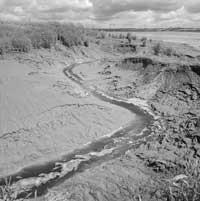Text written in Basque and translated automatically by
Elia without any subsequent editing.
SEE ORIGINAL
Metals and living beings, a complicated relationship
2007/06/01
Galarraga Aiestaran, Ana - Elhuyar Zientzia
Iturria:
Elhuyar aldizkaria
In many definitions of heavy metals it is mentioned that they are toxic and are potential contaminants of water, air and soil, even at low concentration. However, sometimes, despite their dangerousness to living beings, not all of them affect them in the same way, so the tolerance of certain living things to heavy metals can be used for the benefit of other living ones.
Metals and living beings, a complicated relationship
01/06/2007 | Galarraga Aiestaran, Ana | Elhuyar Zientzia Komunikazioa
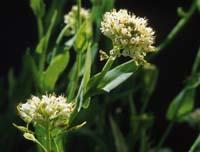
Thlaspi caerulescens is a plant that only grows on land with a high concentration of heavy metals.
C. C. Weller/ARS
Metals are part of living beings, a small part compared to other components, but important, since they fulfill various functions. In the human body, calcium is the most abundant metal (0.23% of all the atoms that compose it are calcium atoms); it is one of the components of the bones, connective tissue and muscles, and has other functions.
Other metals, in a much smaller proportion in the organism, are as essential as calcium. Cobalt, copper, iron, manganese and zinc are microelements, that is, the amount that the human body needs of these minerals is measured in milligrams, and if the organism does not reach the minimum amount, health problems appear.
Iron, for example, is known because anemia occurs if not enough is taken. It is part of hemoglobin and enzymes involved in energy metabolism. It is not, however, the only metal related to hemoglobin or red blood cells. Cobalt cobalt
It is the component of vitamin B 12, associated with the formation of red blood cells. Copper is necessary to transform iron from hemoglobin and assimilate iron from food. It also participates in the absorption of vitamin C.
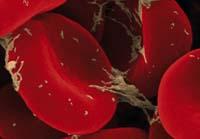
To create red blood cells, iron, copper and cobalt are essential.
J. Kv/CDC
On the other hand, manganese activates the enzymes involved in the synthesis of fats and is related to the assimilation of vitamins C and B 1. Zinc is a component of the digestive enzymes involved in metabolism.
In addition to these microelements, there are others that are classified in trace elements. They are nickel, chromium and molybdenum and are needed in quantities even smaller than the previous ones (micrograms). They intervene in the functioning of the area, in the transport of proteins and in the metabolism of glucose, and in the formation of enzymes, respectively.
All the micro and trace elements mentioned are heavy metals. However, heavy metals are of bad reputation for their aggression against the environment and living beings. Of course, as with many other elements or compounds, the key is largely in dosage. However, other heavy metals have no function in the organism and are toxic in the lowest dose. They are mercury, lead and cadmium.
However, mercury, lead and cadmium are found in people's daily lives, as are other heavy metals. Batteries and batteries contain lead, mercury, cadmium and nickel; steel is made of iron, and thanks to this rise the buildings; copper is used to drive the power of light; cars are made of steel, aluminum and copper; appliances and many of the appliances that are used in laboratories as medicine are metallic... It is clear that heavy metals are almost indispensable.

People live surrounded by heavy metals.
From file
Due to its use, it is not surprising that the environment reaches even though there are technologies and methods to avoid or reduce the damage they cause. Many are cumulative, since the body does not expel them and, in addition, as it ascends in the trophic chain, the concentration increases. That is, the living beings that are at the base of the trophic chain accumulate metal, even those who eat them, increasing the concentration… until reaching the upper level of the trophic chain. And there is man.
More than dosage count
However, not everything is a matter of dosage, but also of the chemical form in which metals have toxicity. For example, the mercury element is not toxic by mouth, since it is little absorbed and quickly removed. In contrast, mercury vapor is absorbed into the lungs, and chronic and acute poisoning occurs.
In general, organic compounds of metals are more harmful than inorganic compounds, such as organic compounds containing mercury and cadmium are 10-100 times more toxic than inorganic compounds. But there are always exceptions, and in the case of arsenic, inorganic compounds are the most toxic.
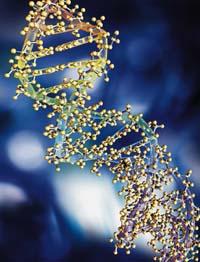
Heavy metals alter the structure of DNA and, therefore, cause cancer.
From file
In addition, oxidation status also influences toxicity and chromium is a clear example: Cr 3+ is an essential element, but Cr 6+ is very carcinogenic. In addition, there can be interactions between compounds, so its effect on the body can be greater or smaller than individually.
On the other hand, some forms of metals are more useful than others, that is, they are more easily soluble in the environment and arrive at living beings, so they have more chances of damaging them. Factors such as hydrophobicity, temperature, pH, ionic interactions, etc. They influence the availability of metals and the greater or lesser penetration in the bodies of living beings (bioavailability). For example, by increasing the temperature increases the bioavailability of metals, cobalt chloride and copper chloride dissolve much more easily by lowering the pH of the soil from 8 to 7 and cadmium chloride is very toxic in salted water.
Deep damage
In this way, metals can adopt one form or another depending on the conditions, and thus penetrate the organism, for example inhaled, aspirated (plants) or ingested (animals). Then they reach the inside of the cells by different pathways. There it is possible to remove, form a compound and become inert or accumulate in some compartment inside the cell. In these cases, it does not cause damage.

There can be interactions between compounds containing heavy metals, so its effect on the body can be greater or smaller than individually.
From file
But the cell may not be able to do so and then it can be dangerous. In fact, when reaching the cells, iron and other metals can interact with peroxide oxide oxide (H 2 O 2), resulting in radical oxhidrile (OH). This radical, extremely oxidizing, causes damage to the lipids of the cell membrane, proteins, nucleic acids and, in general, produces metabolic damages that can lead the person to death.
On the other hand, some metals compete with essential metals. Replaced by chain reactions that prevent or modify the functions of biomolecules.
They influence not only metabolism, but also DNA. If they reach the cell nucleus they bind to DNA proteins. Metals also interact with peroxide oxide inside the core and the radical oxhidrile that form oxidize bases or deoxyribose. In addition, the loss of bases can have other consequences, such as the break of double propellers and formation of simple, DNA protein bridges or bridges between two DNA molecules.
In DNA replication, heavy metals inhibit the enzymes involved in the process, leading to errors. They also produce changes in the synthesis of nucleotides and in the processes of methylation of DNA. All these changes affect the structure of DNA and can be a cause of cancer. What's more, although there is no change in the sequence of DNA, heavy metals are able to hinder the expression of genes due to changes that occur in proteins that intervene in the transcription process.
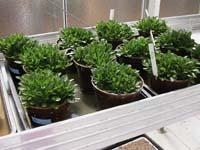
Thlaspi caerulescens is a plant that absorbs zinc, cadmium and other heavy metals and stores them in leaves without suffering damage.
O. District District District
Bioremediation remediation
Heavy metals, therefore, cause serious effects on living things. But it is not the same: some organisms have a great tolerance to heavy metals. Bioremediation is based on the use of living beings (microorganisms, fungi and plants) or their enzymes, which have the ability to absorb metals, accumulate, transform or remove them, to eliminate or neutralize them.
In many places, certain plants are used to clean soils contaminated with heavy metals. In the Basque Country, NEIKER, Instituto Vasco de Investigación y Desarrollo Agrario and the team of Plant Biology and Ecology of the UPV/EHU Jose Maria Becerrilak, for example, are investigating the use of the plant called Thlaspi caerulescens to restore the health of the soils of Karrantza and some areas of the left margin. In fact, in these areas there were mines, so their lands are contaminated with heavy metals (iron, zinc, cadmium, lead).
According to Lur Epelde, who works at NEIKER, soil health is measured by the microorganisms that live there. They are the bioindicators, which study the activity of microorganisms, biomass, biodiversity, etc. And they know what is the state of health of the earth. If the indicators indicate that the soil is diseased, they implement a phytoextraction technique to regenerate the soil, such as the planting of Thlaspi caerulescens.
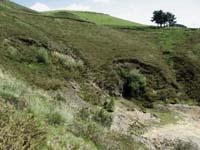
The use of the Thlaspi caerulescens plant is being investigated to restore soil health in some areas of Karrantza and the left bank of Bilbao.
L. L. Epelde
This plant is found spontaneously in lands close to the mines and only grows in areas with a high concentration of heavy metals. Its main characteristic is that it absorbs zinc, cadmium and other heavy metals, storing them in leaves without suffering damage. Specifically, it keeps them in leaf vacuoles. Thus, in the leaves it can accumulate 10,000 ppm of cadmium and 30,000 ppm of zinc, that is, it is a hyperaccumulator.
Despite its small size, it is a plant that extracts large amounts of metals from the soil, making it ideal for restoring contaminated areas. They plant, grow and receive the harvest and replant it. Over time, the health of the soil improves considerably, which is perceived in the microorganisms of the soil. Bioindicators show that the plant favours soil and not only because it cleans it with metals. In addition, the roots of the plants are a source of organic compounds that improve the physical structure of the soils.
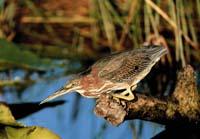
Some plants that absorb metals through their roots are appropriate to clean wetlands with heavy metals.
From file
Other lines are also being worked at NEIKER. In addition to hyperaccumulators, soil plants that do not accumulate as many metals but grow much, such as wine and sorghum. With this type of plants add chelators (EDTA, EDDS...) to the soil to increase the availability of metals and facilitate the absorption of metals.
It can also take advantage of the absorption capacity of metals by plants through the roots. Lur Epeld acknowledges that they have not yet tested this system at NEIKER, but is suitable for cleaning heavy metals in wetlands and underground waters.
The interaction between metals and living beings is undoubtedly complex and dangerous. But we must not forget that without metals there would be no life, at least the same as that which exists today.
Heavy metals in the sea
One of the great poisoning of heavy metals has been fish. A clear example of what happened in 1956 in the Japanese bay of Minamata is that methylmercury emitting a plastic factory was deposited in fish and seafood. The inhabitants of the area ate them and that year 44 people died. Many others suffered serious consequences that were affected in the next generation.
Perhaps for this and similar fact, it is very widespread the belief that the main source of food-based heavy metals are fish and seafood.
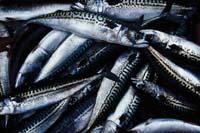
The belief that fish are the main source of heavy metals based on food.
(Photo: From archive)
As often happens, however, it is believed to be half corrupt. Although most of the mercury ingested in the Basque Country with food comes from fish and seafood, in some places in France the main source is mushrooms. The lead taken by the inhabitants of the Basque Country comes mainly from alcoholic beverages, followed by bread and fruit. The main sources of cadmium are cereals and vegetables, as well as tobacco in smokers.
However, the concentration of heavy metals in food is far from toxic and the regulations in this regard are extremely strict. In the Basque Country, AZTI-Tecnalia is responsible for analyzing the concentration of heavy metals in marine species, and according to Victor Valencia, it is very difficult to reach potentially dangerous concentrations for the consumer, since they not only control the final product but also monitor the quality of the waters.

In France it is mushrooms that consume more mercury and in Euskal Herria lead comes mainly from the wine.
(Photo: From archive)
Apart from the controls, Valencia explains the complexity of the biogeochemical pathways of heavy metals. First, it must be taken into account that heavy metals or any other element are diluted when they arrive at the sea. In addition, due to the composition of marine water, compounds are usually formed, they join and precipitate. For this reason, the concentrations of heavy metals in marine waters are very low, inferior to those in continental waters.
In principle, there is a risk of accumulation in large predators (tuna, sharks...), but there are also many agents involved and there are no general rules. In fact, "although the trophic chain is said to accumulate metals, it is not always so," warns Valencia. A part is eliminated and, in addition, the concentration varies according to the cycle. In young oysters and mussels, for example, the concentration stabilizes: it continues to accumulate, but at the same time grow.
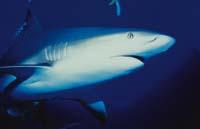
In principle there is the risk of accumulation of heavy metals in large predators, although many agents are involved.
(Photo: From archive)
Finally, Valencia says that many times sudden deaths related to the dumping of a metal are not due to metal. In most cases, the vivo kills the acids of the solution, not the metals in dissolution. The killers are usually oxidizing (bleaches), acids and bases.
For all this, Valencia is positioned in favor of heavy metals contributing to their measure the risk they generate in marine living beings and their consumers.
After the accident of Aznalcoll
On May 25, 1998, the well that housed the mining remains of Aznalcollar (Seville, Spain) was cracked. Consequently, 6 hm 3 of water and acid sludge were poured into the Guadiamar River and surrounding lands. The Guadiamar is a branch of the Guadalquivir that takes water to the wetlands of the Doñana National Park. For this reason, the accident had a great international repercussion.
The Pyrenean strip of the southeast of the Iberian Peninsula is the most important in Europe and one of the largest in the world in metal sulphies. Aznalcollar mineral has copper, lead, zinc and silver. The minerals were extracted outdoors and from the residues, sulfuric acid was obtained. The rest was collected in the well.

(Photo: Wwal)
At the time of the accident, the dumping caught land of rice, cotton and cereals. It also contaminated the olive trees and the lands in which fruit trees were grown, reaching the Guadiamar River. It caused a huge economic loss and caused great environmental damage. The harvest was lost, all aquatic species died, and the fishing of survivors was forbidden.
The mines were closed and soon began to take measures to recover the space. First, the mud was removed and then the restoration of the area was carried out. In this sense, the area has been an important laboratory to test bioremediation techniques.
At present there are still remains of the spill. In the river, for example, the same species have begun to appear before the accident, but there are still few specimens. Yes, the concentration of heavy metals in fish has dropped a lot, but the health of the Guadiamar River is mediocre, not only for that discharge but also for the pressure that is supported before and after. However, the General Council of Scientific Research of the Spanish State (CSIC) considers that the measures adopted to date have been adequate, so they will continue working in the same line.
Galarraga de Aiestaran, Ana
Services Services Services
More information More information
2007 2007 2007 2007 2007
Security security security security
042 042 042
Biology; Biochemistry; Anatomy/Physiology; Health; Environment; Ecology; Chemistry
Dossier dossier
Description Description Description Description

















